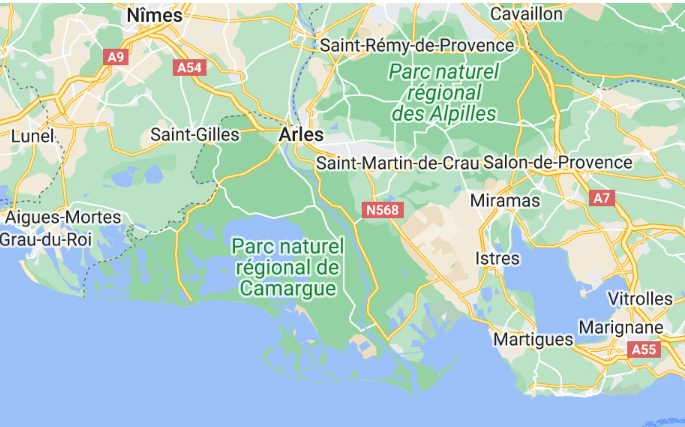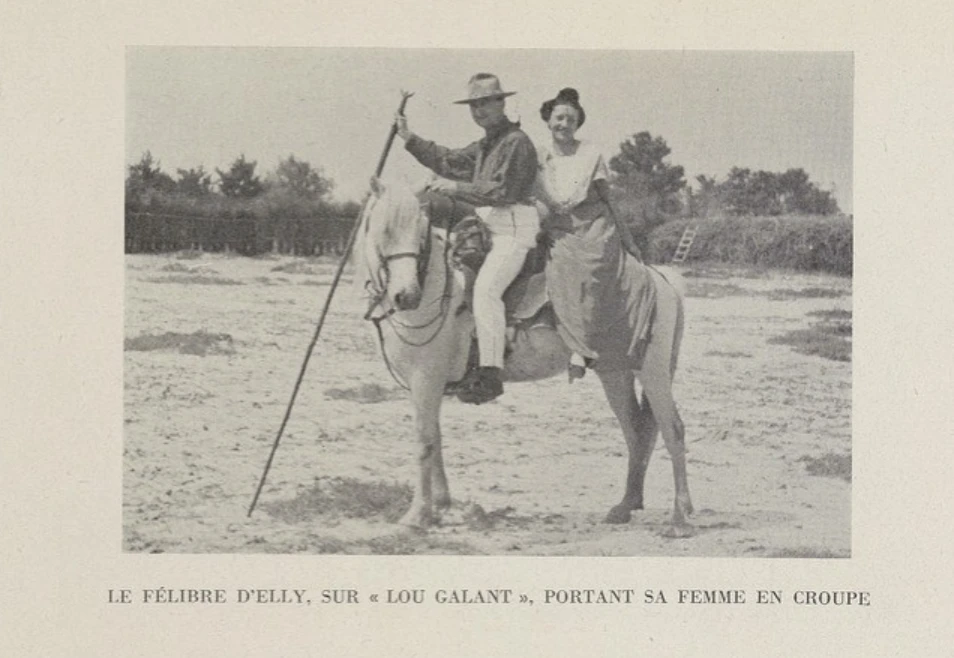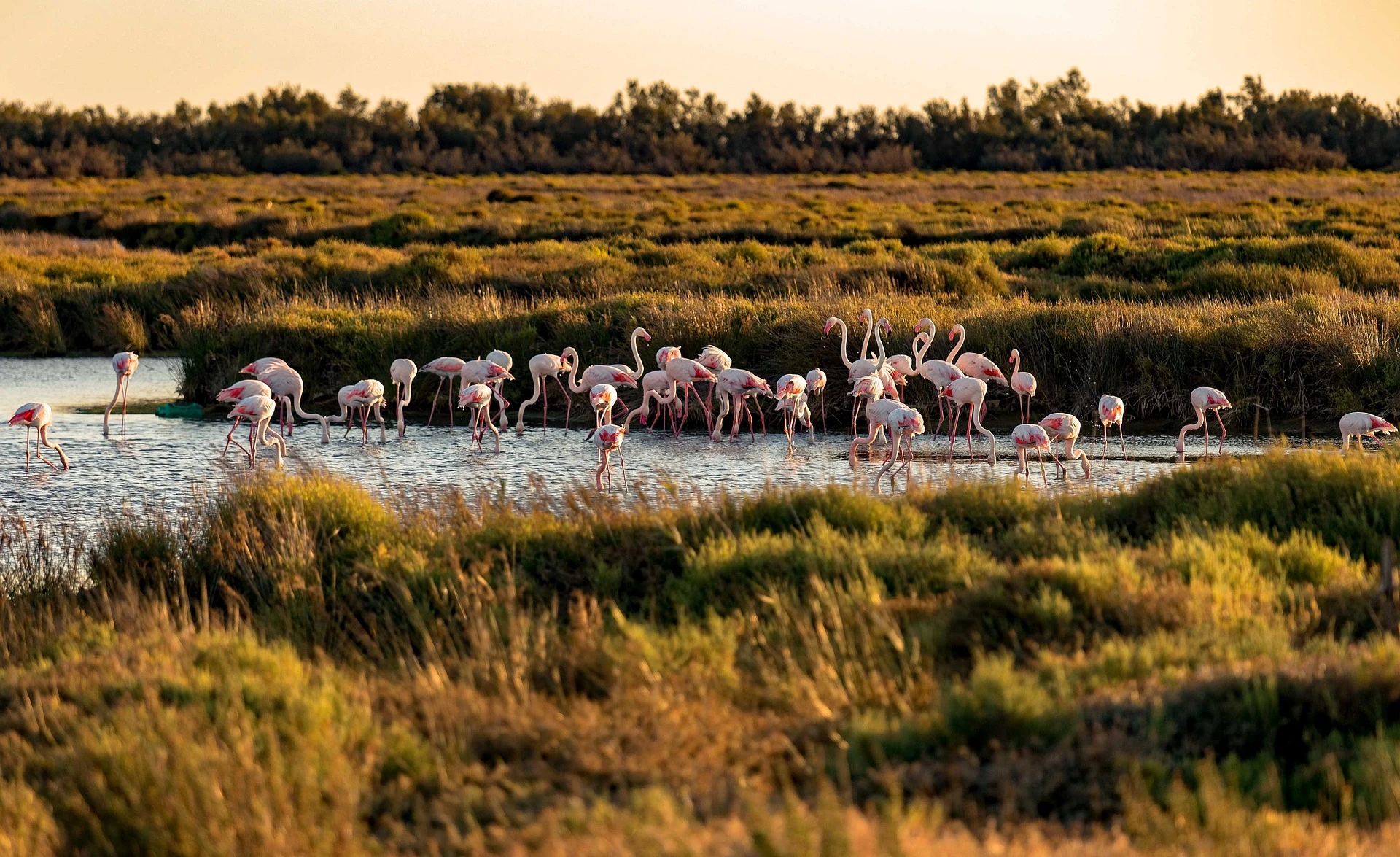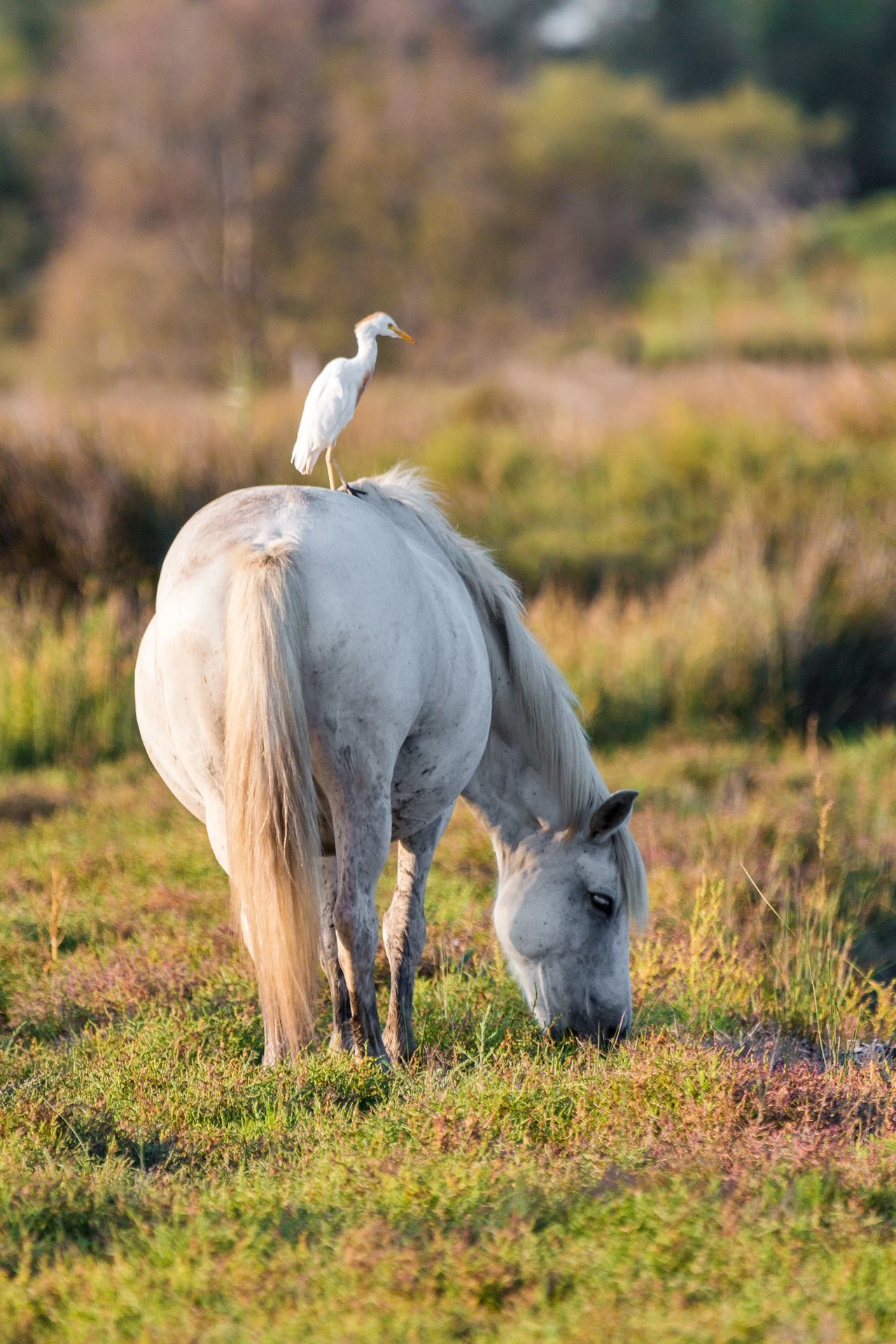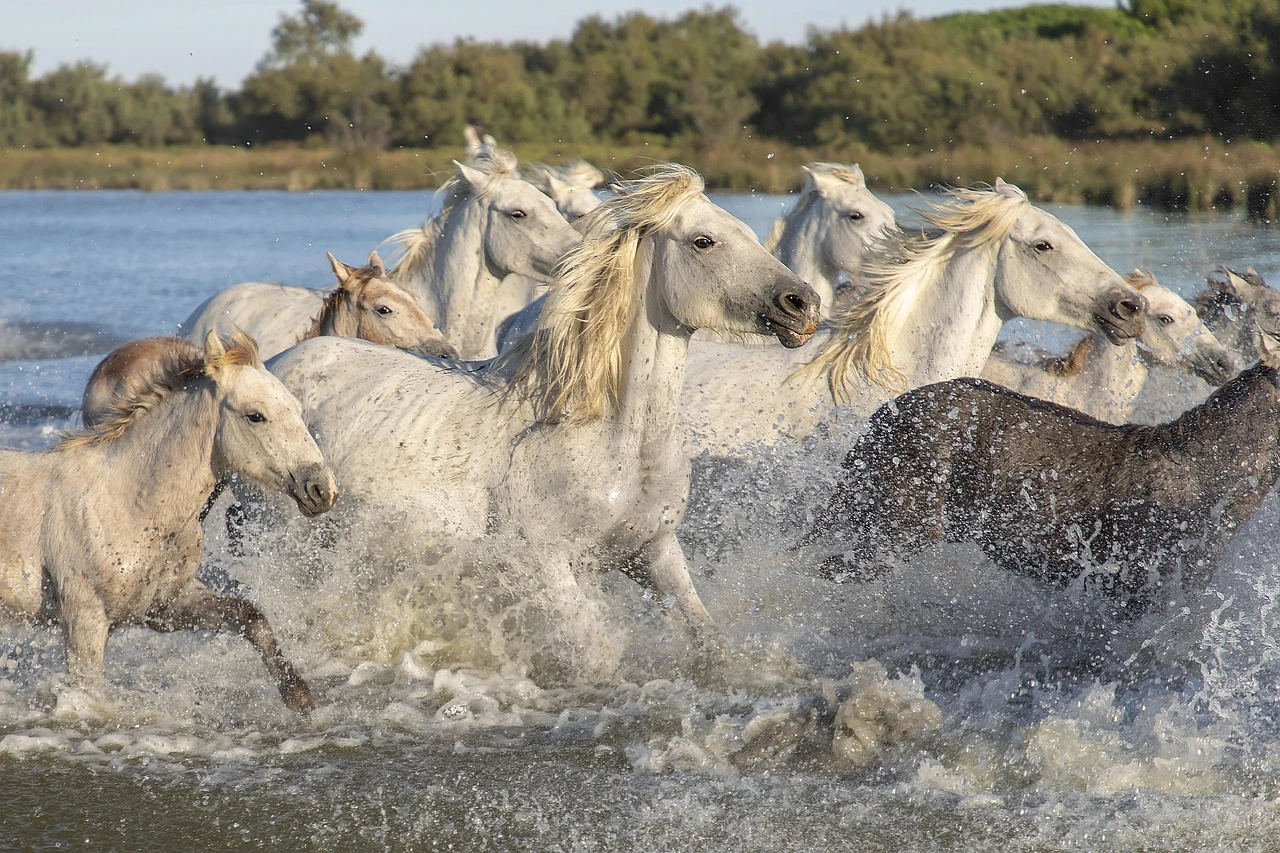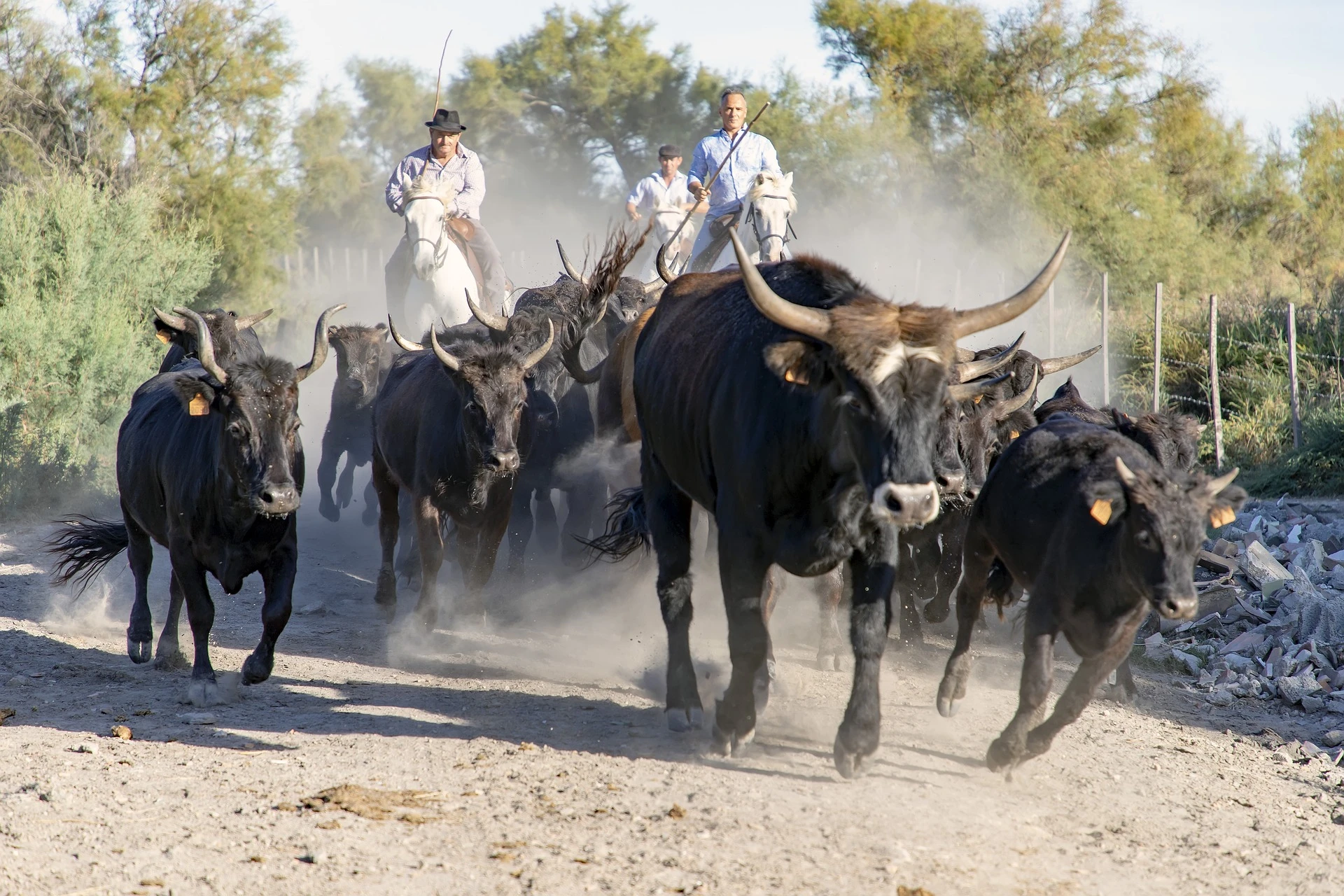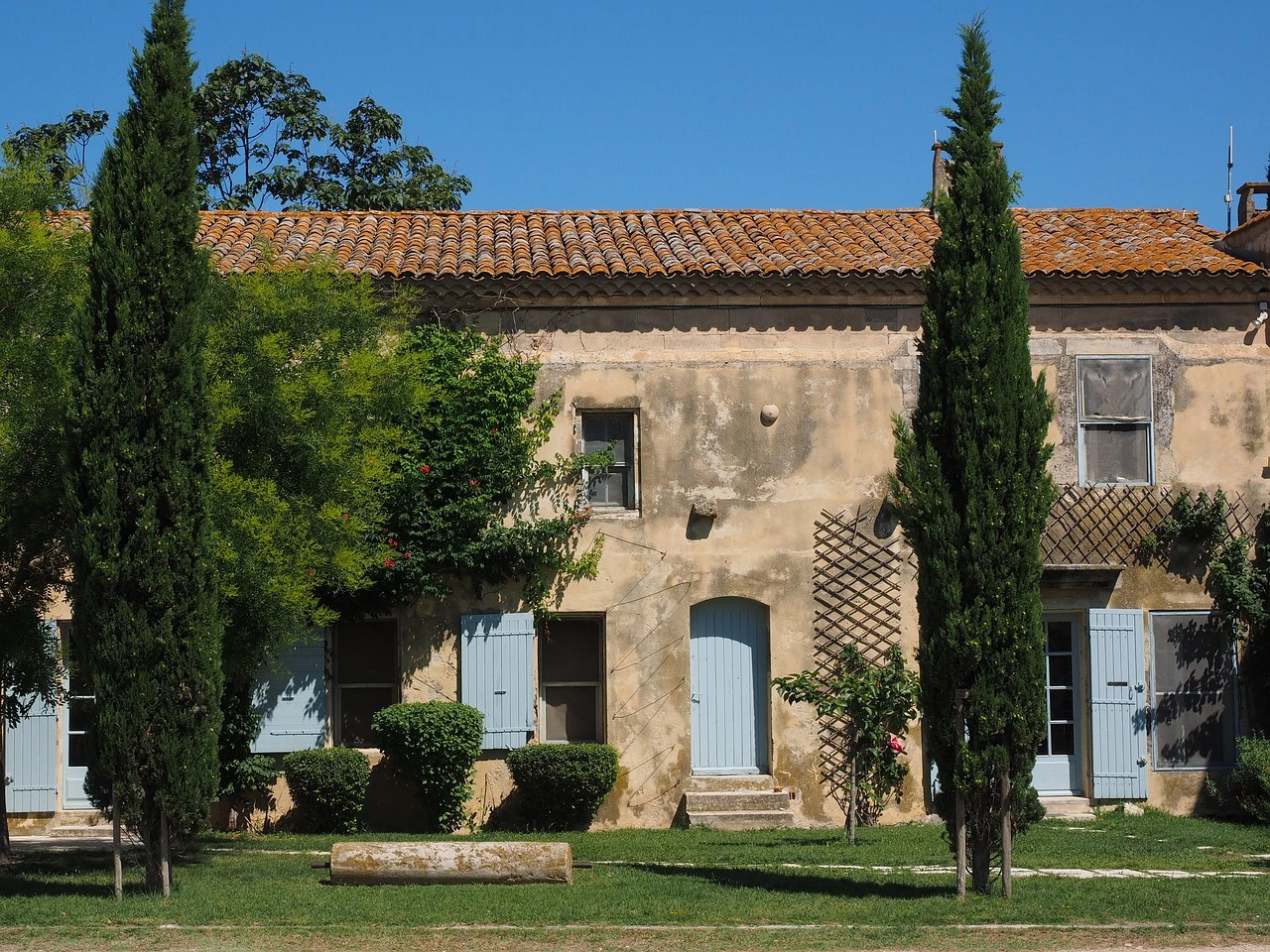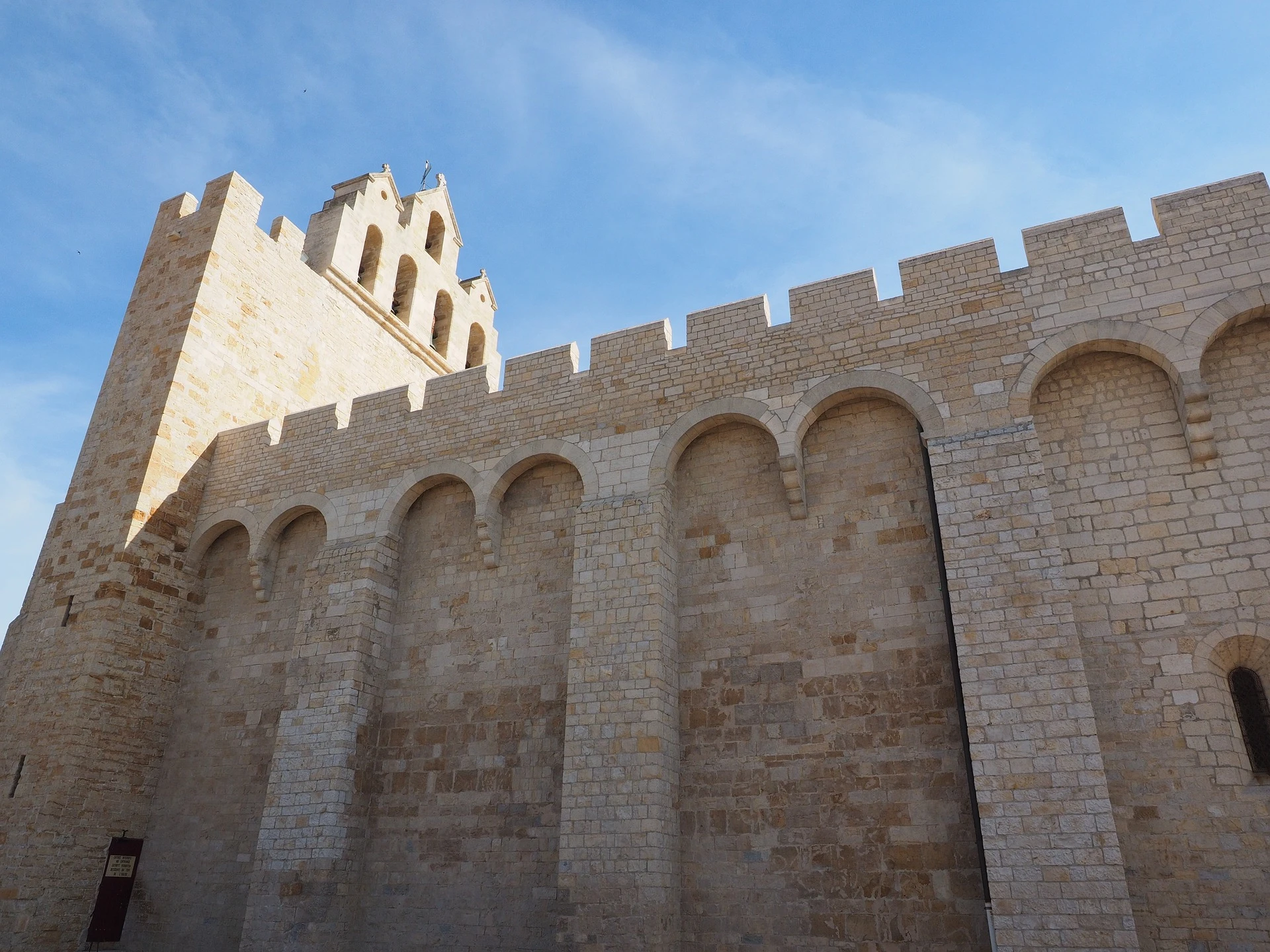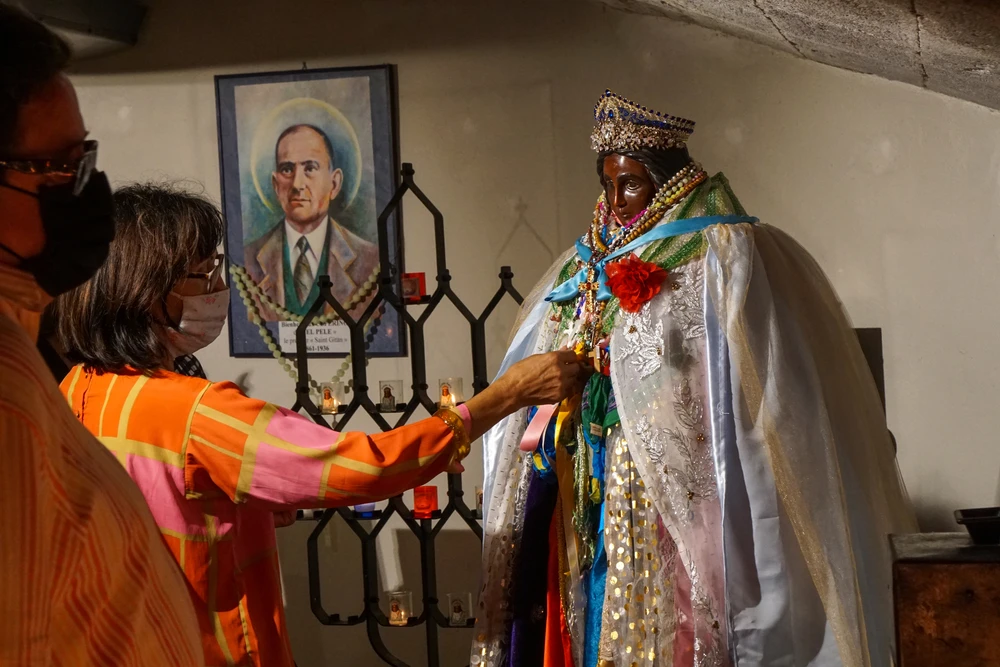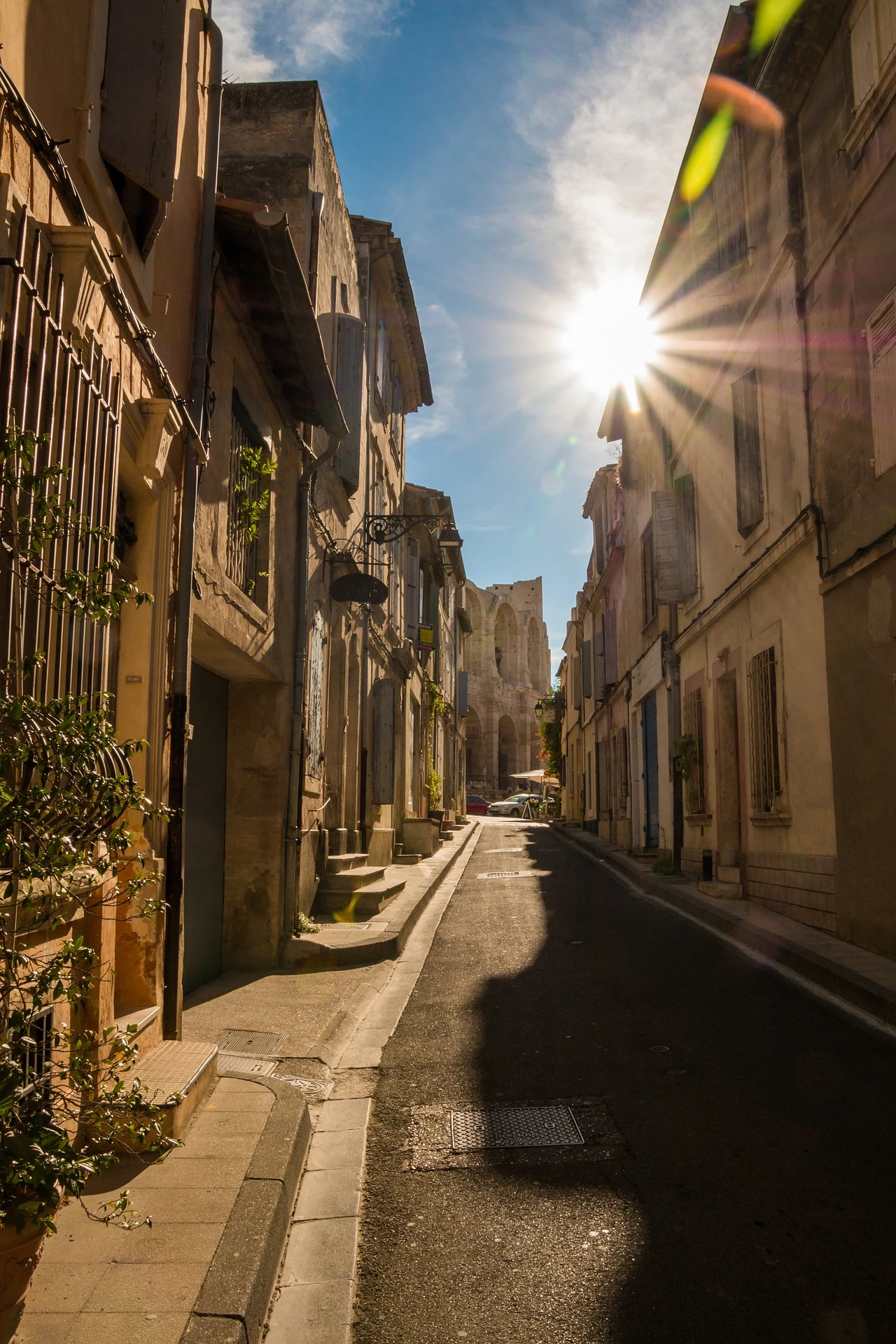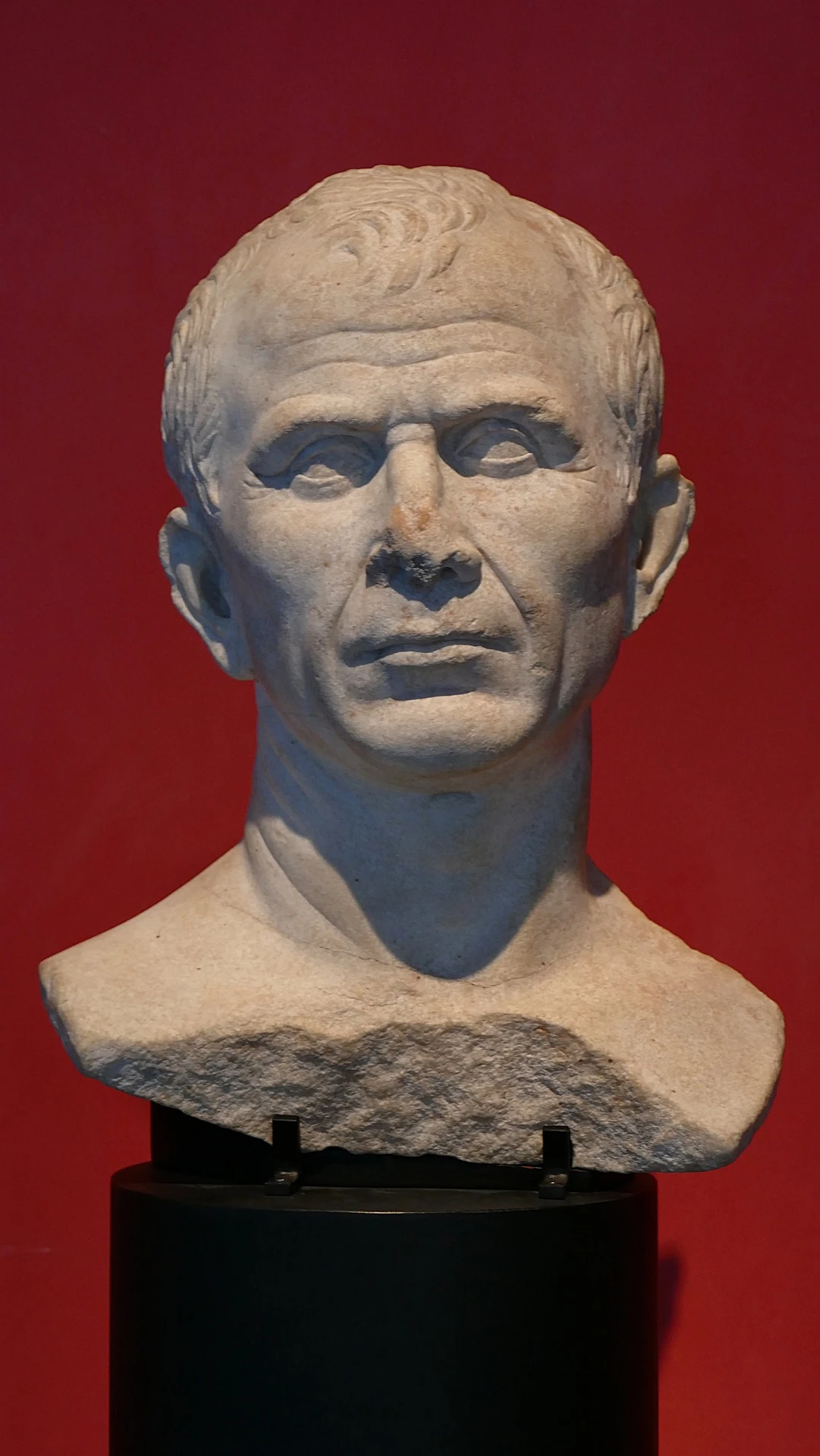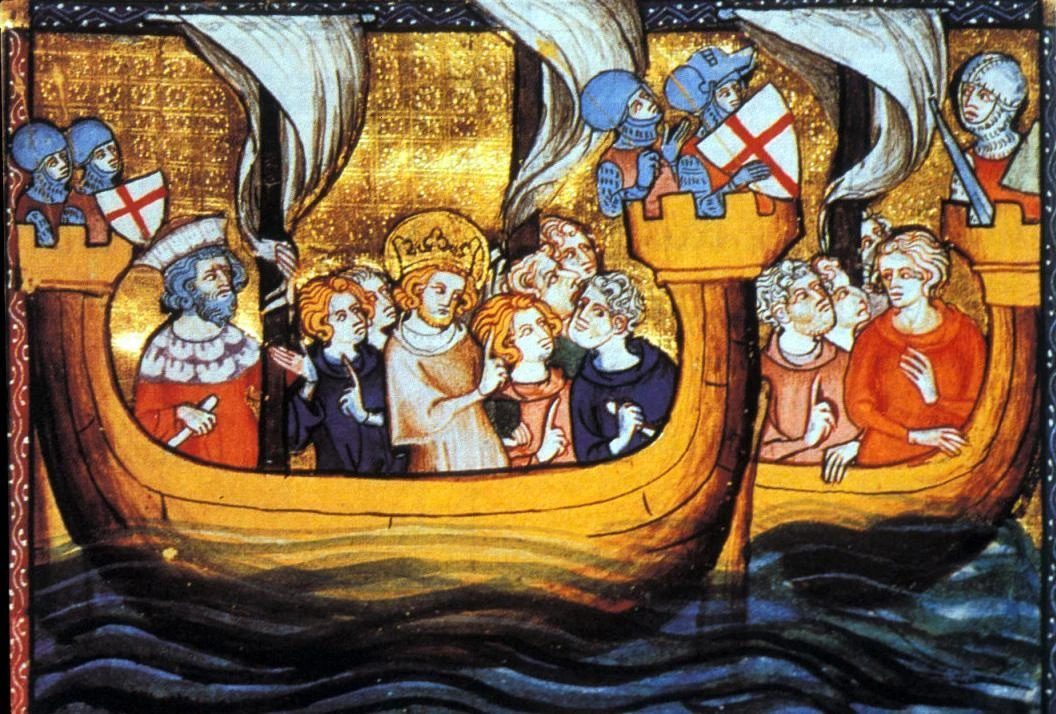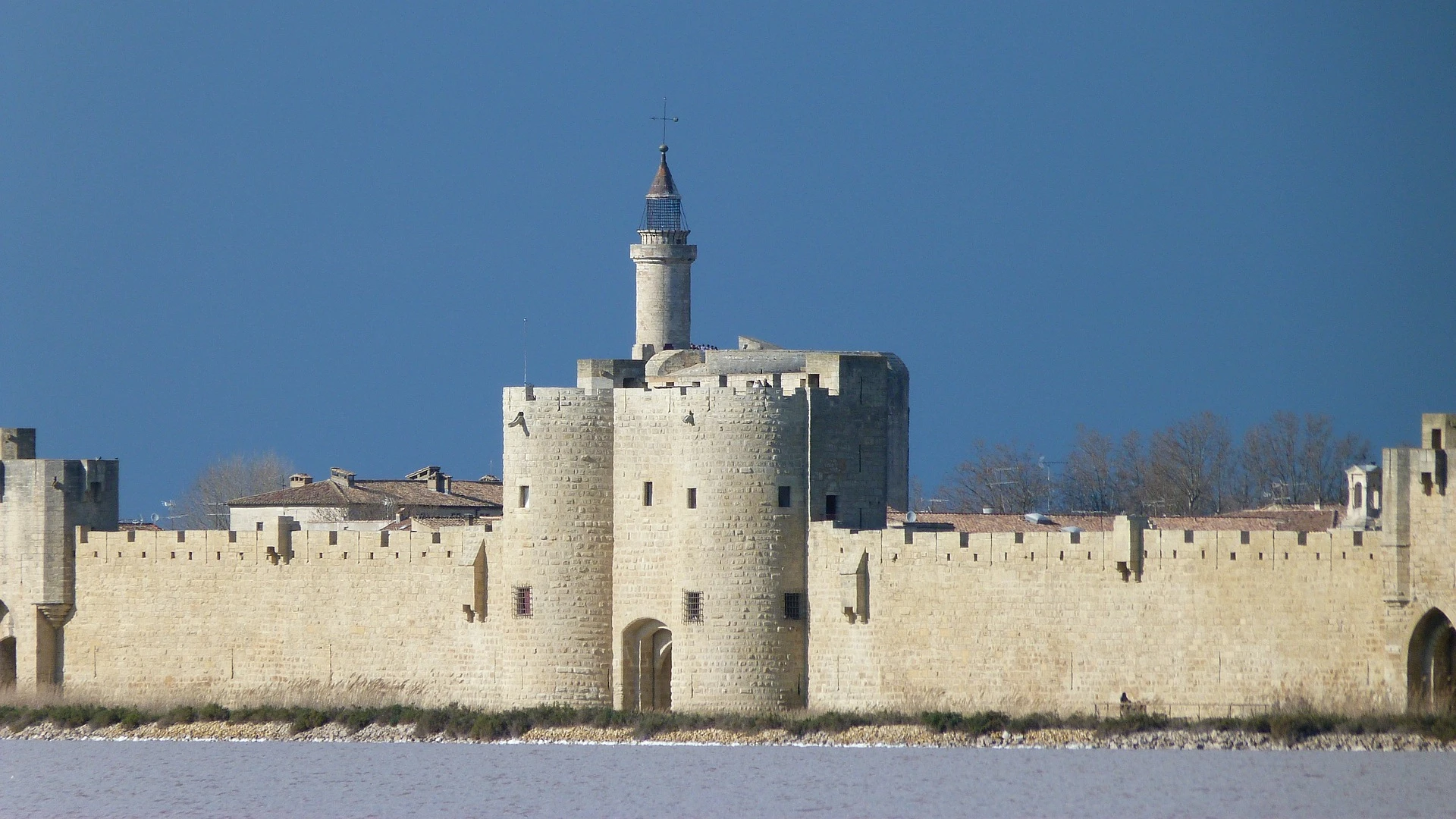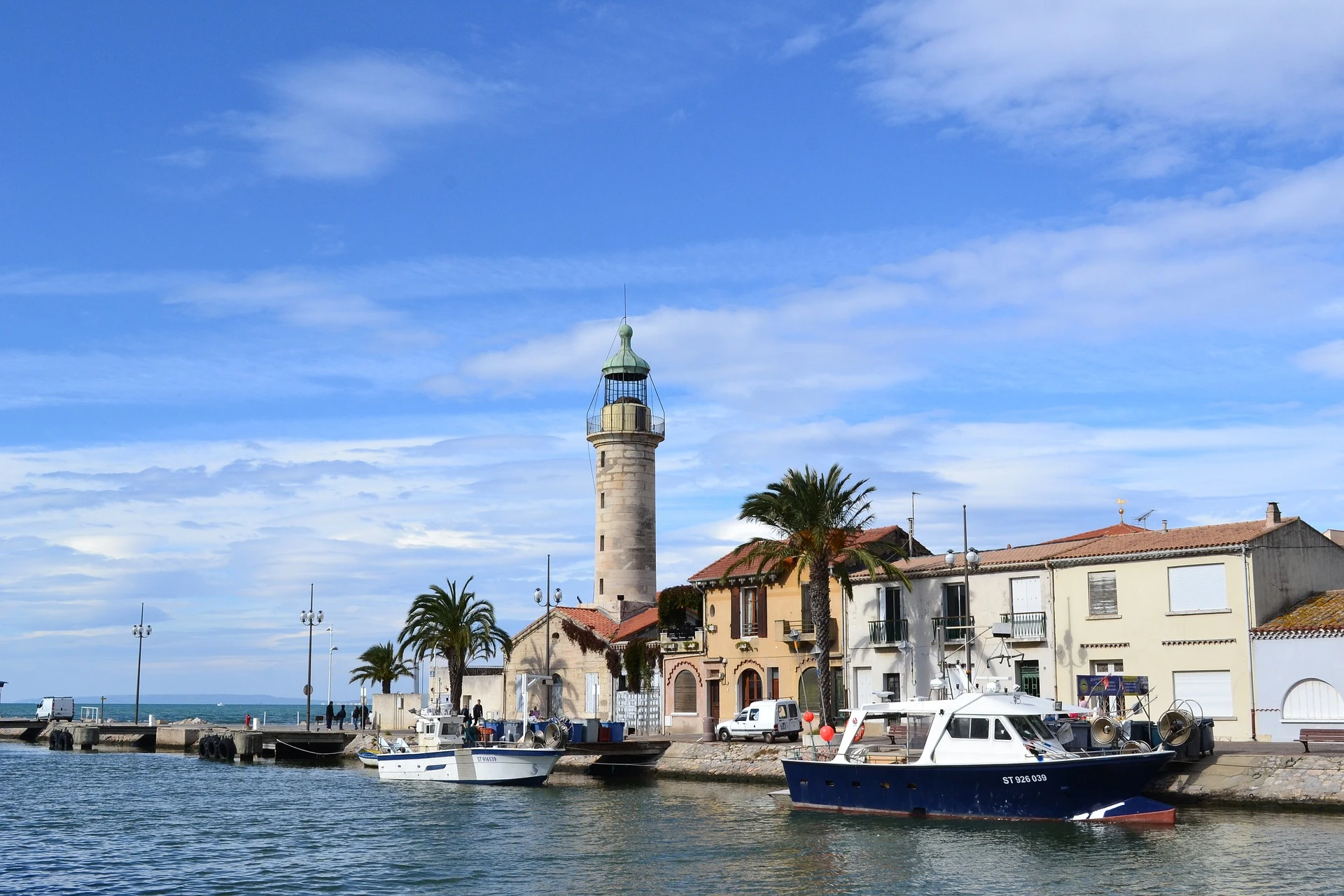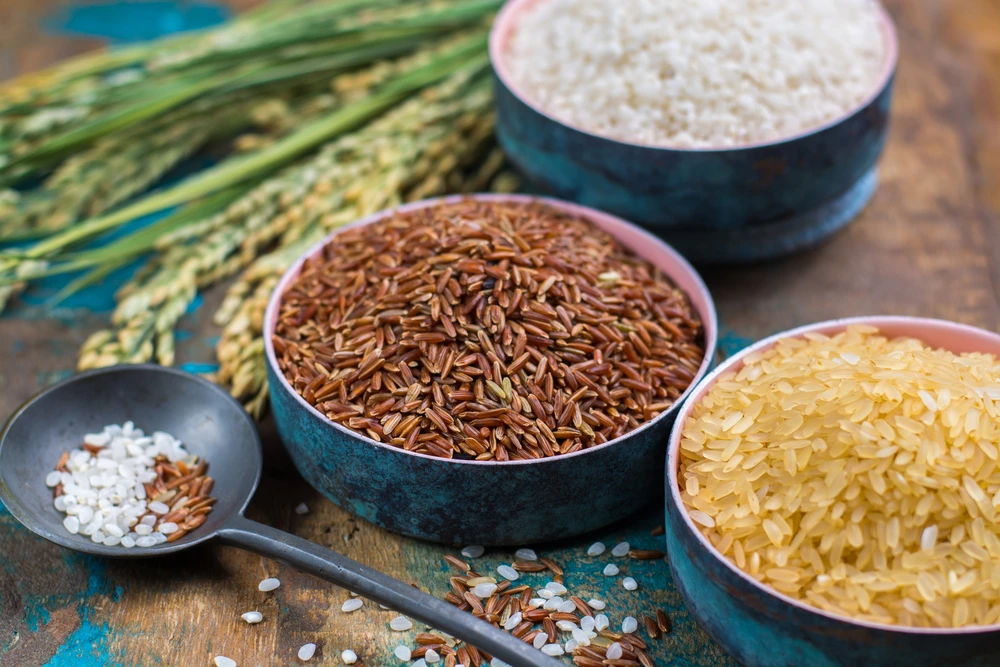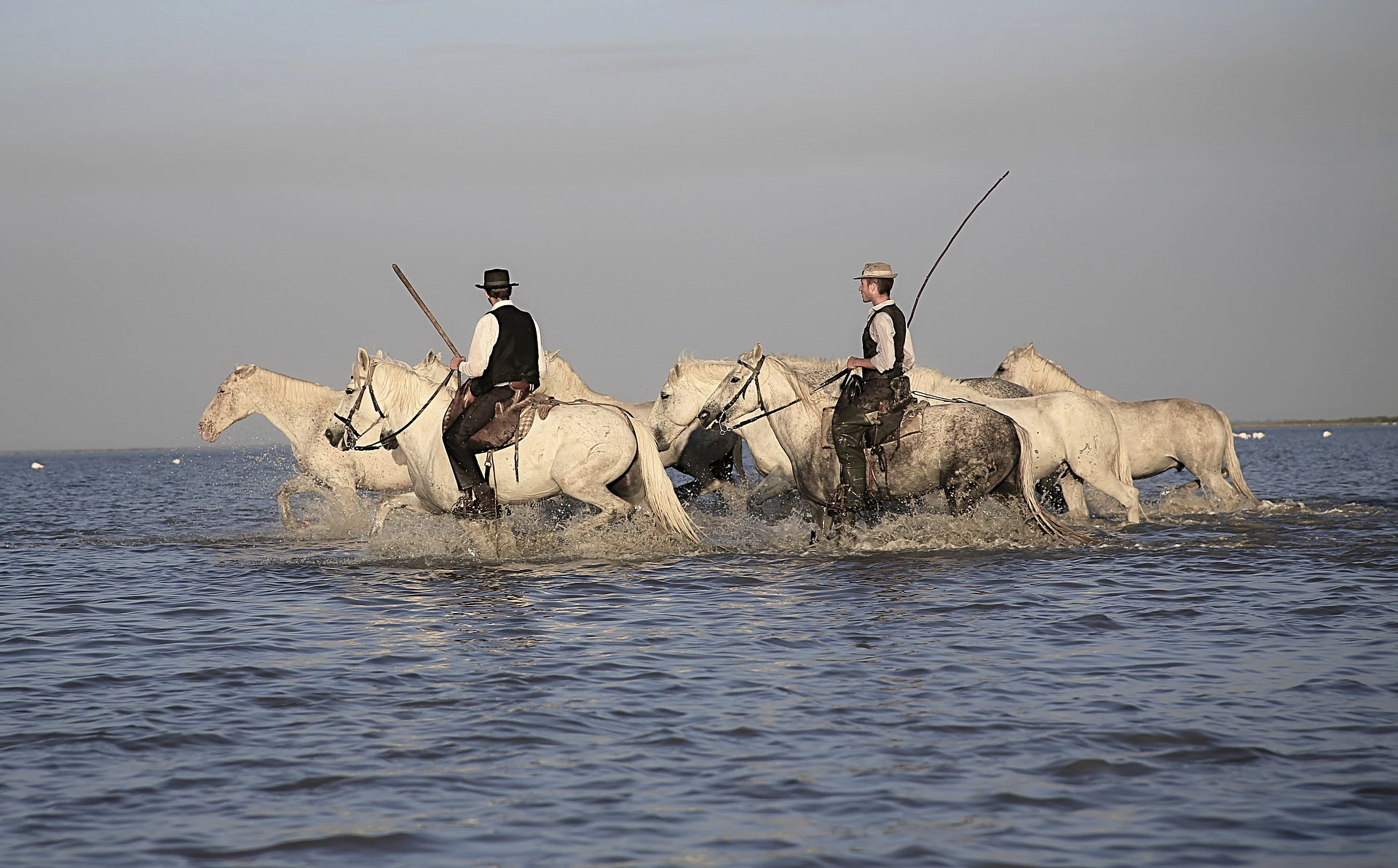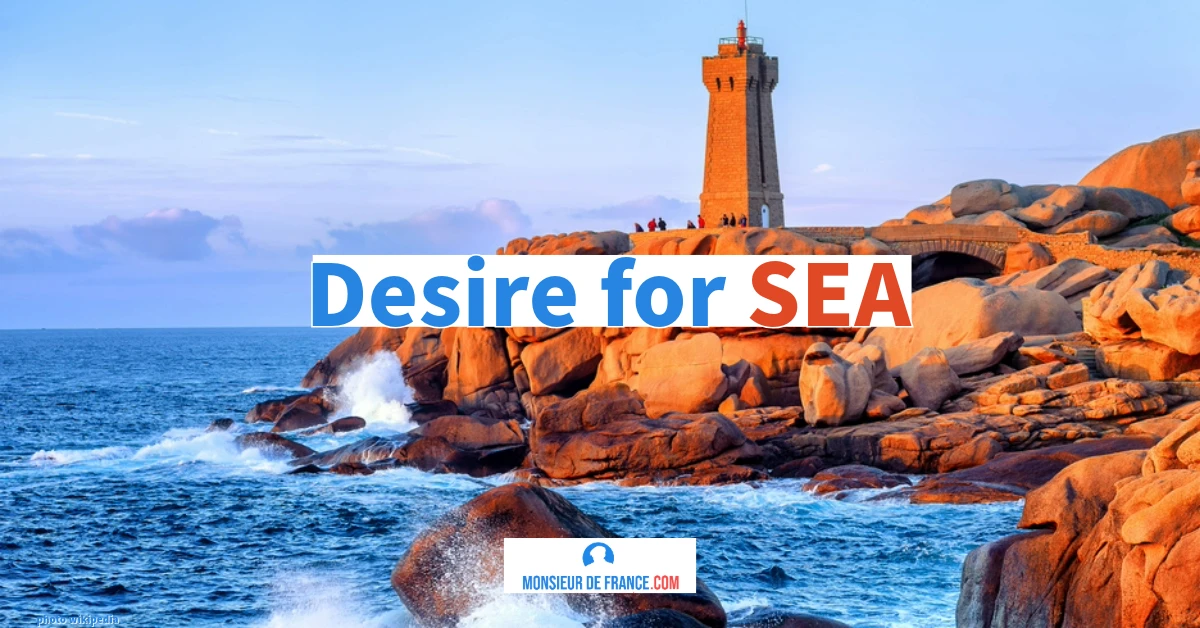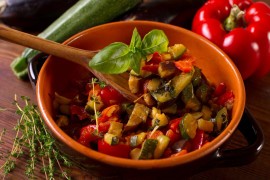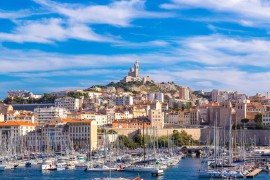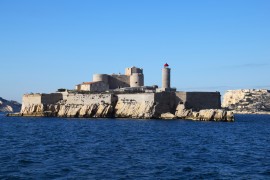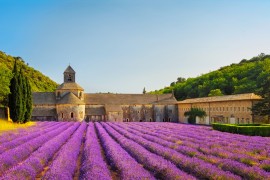The Camargue, a vast, wild delta of the Rhône River in southern France, fascinates visitors with its unique landscapes, exceptional wildlife, and living traditions. With its nature reserves, manades (herds of wild horses), beaches, iconic villages, and local cuisine, it appeals to travelers seeking authenticity and nature.
The Camargue: essential information before visiting
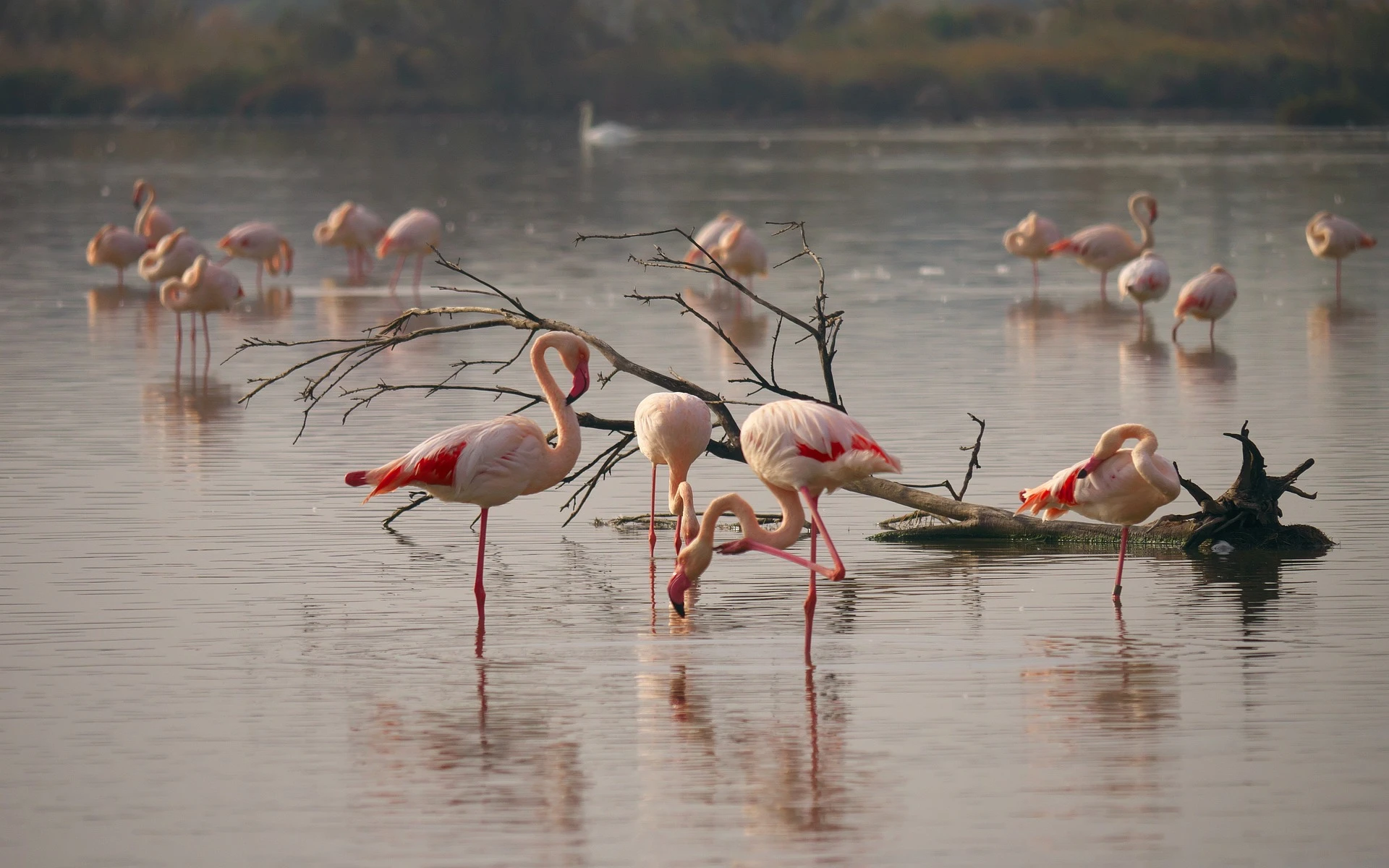 Flamingos are emblematic of the Camargue's wildlife. Photo selected by monsieurdefrance.com: by gayulo from Pixabay
Flamingos are emblematic of the Camargue's wildlife. Photo selected by monsieurdefrance.com: by gayulo from Pixabay
Where is the Camargue located? Location and geography
Map of the Camargue. Google Map screenshot.
A land without administrative boundaries between Gard and Bouches-du-Rhône
It is difficult to define a region that has no administrative boundaries, but we could say that the Camargue covers the Rhône delta on the borders of the Gard and Bouches-du-Rhône departments. To the north is the capital: Arles, part of which is the largest municipality in France. The heart is in the south, along the coast, and consists of Saintes-Marie-de-la-Mer. To the west, it borders the medieval city of Aigues Mortes and Le Grau du Roi. To the east, it is close to Fos-sur-Mer, not far from Martigues.
The three Camargues: Camargue, Petite Camargue, and Plan du Bourg
There are three Camargues. The "Camargue" is located between the two branches of the Rhône, the Petit Rhône and the Grand Rhône, in the center; the "Petite Camargue" is to the west in the Gard department; and the "Plan du Bourg" is to the east of Salin de Giraud and covers the Crau Plain.
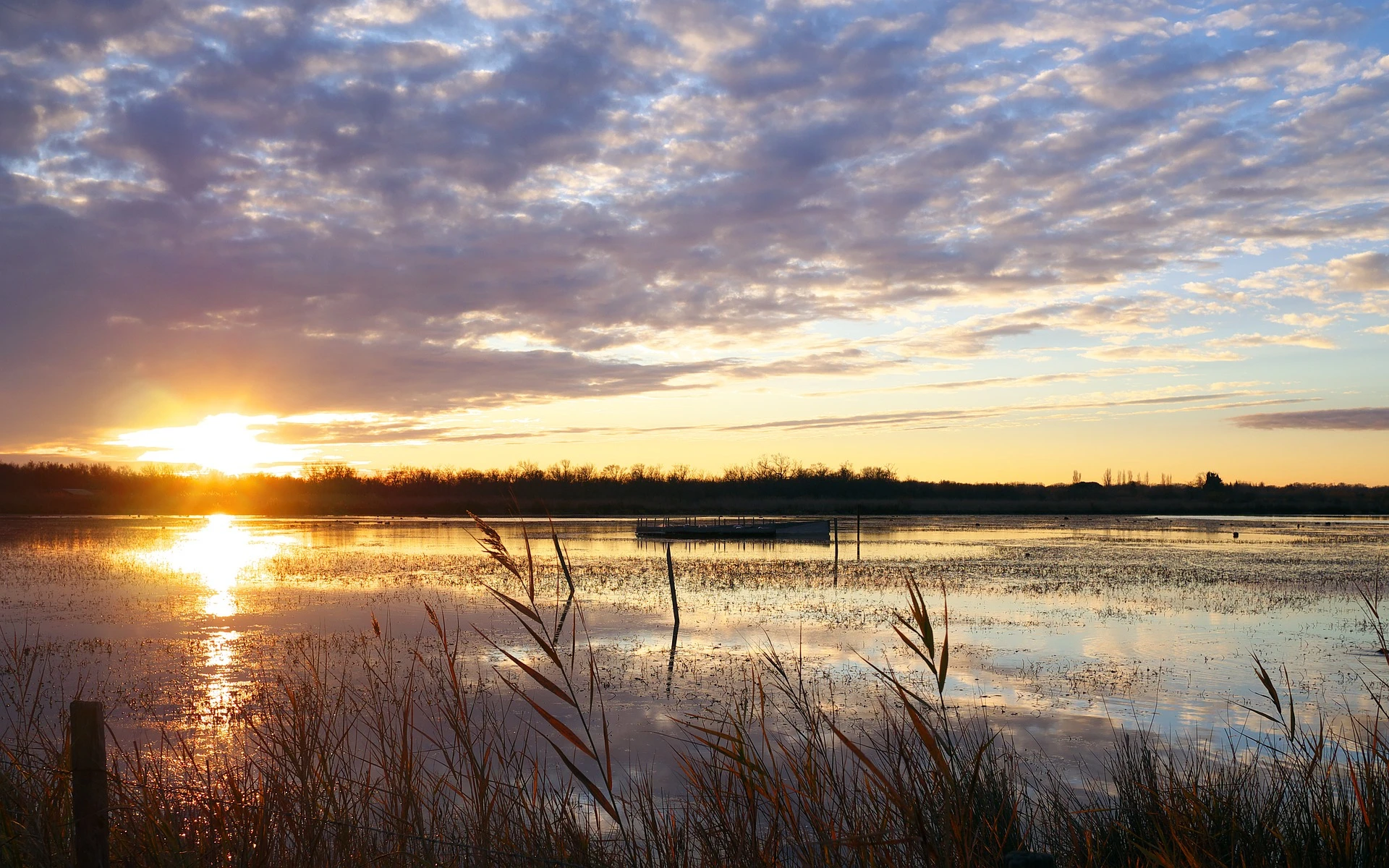 Water is never far away in the Camargue. Photo selected by monsieurdefrance.Com: by gayulo from Pixabay
Water is never far away in the Camargue. Photo selected by monsieurdefrance.Com: by gayulo from Pixabay
This is where the salt marshes are located. Water is everywhere, along the Mediterranean coast, but also in the ponds. The largest is the Vaccarès pond, but there is also, nearby, the Imperial pond, the Etang de la Dame, and to the west, the Melégal pond and the Scamandre pond. The Camargues Regional Nature Park covers 150,000 hectares and protects the natural treasures that we will discover here. The important thing to remember is that the Camargue is very rural, sparsely populated, and a wild island in a densely populated corner of France.
Une carte de la Camargue. Image choisie par monsieur de France via Wikipedia. Par ChrisO, revision by Ulamm (d) — Combination of CIA World Factbook map (Image:Fr-map.png) and Demis Map Server (http://www2.demis.nl/mapserver/mapper.asp) data with additional annotations and modifications by self., Domaine public, https://commons.wikimedia.org/w/index.php?curid=53393703
The Camargue: 10,000 years of nature and 2,000 years of human history
From the Rhône Delta to the great Roman agricultural estates
The Rhône Delta was formed 10,000 years ago. It is a fertile land that did not escape the agricultural eye of the Romans, who established large agricultural estates there. It is believed that one of them, Senator Camars, of the Annia gens, gave it its name from "camaricus," which means "belonging to Camar." Camaricus is thought to have become Camargue over time. With the sea very close by and extensive marshes, dykes were built in the Middle Ages. The forest that stood there was also cut down and salt began to be harvested from the salt marshes.
Dikes, salt, and rice: how humans shaped the Camargue
In the 18th century, and especially in the 19th century, the dikes became more important. Rice really appeared in the 19th century, around 1840, even though Sully, minister to Henry IV, had already wanted it in the 17th century. The cultivation of rice, through the development of rice fields, made it possible to control the floods of the Rhône. Camargue rice, after nearly disappearing after World War II, is now back in full force, covering 20,000 hectares.
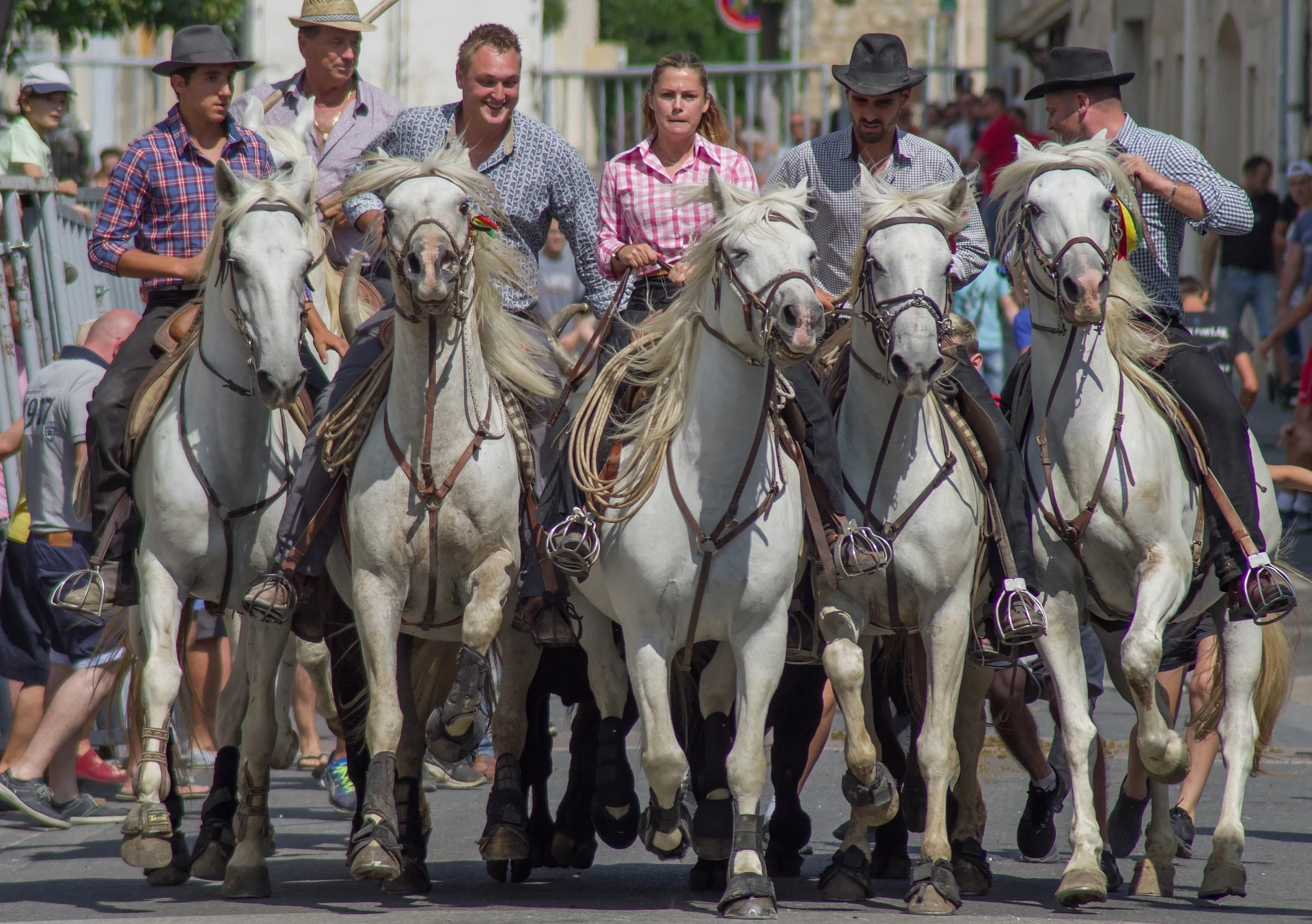 A herd of Camargue cattle. Image selected by monsieurdefrance.com: by jacqueline macou from Pixabay
A herd of Camargue cattle. Image selected by monsieurdefrance.com: by jacqueline macou from Pixabay
Camargue identity: traditions, dialect, and way of life
The Camargue has developed its own identity with a dialect, Camarguais, and customs that are known far beyond its borders.
Manades, gardians, and Camargue culture
The manades, these semi-wild herds, led by men on horseback, are as much a part of this identity as the gatherings at Saintes Maries de la Mer.
Inhabitants of Camargue in the book 'La Camargue gardiane / D'Elly'; preface and Provençal poems by the Marquis de Baroncelli-Javon; illustrations by Rivet and Leliepvre; photographs by George and Grün. Published by M. Dalaveau (Paris) 1938. Photo selected by monsieurdefrance.com via Gallica.fr / BNF
What to see in the Camargue? The must-see attractions
Flamingos are emblematic of the Camargue region. They are at their pinkest in winter. Image selected by monsieurdefrance.Com; by Association Posidonia from Pixabay
The Camargue, a land of untamed nature
The Camargue is a treasure trove for nature lovers. Its wildlife is unique and varied. The most famous species are the famous pink flamingos. Their population is estimated at between 15,000 and 20,000 pairs, which come here to breed every year. Interestingly, it is the shrimp they eat that give them their pink color, which is never as pink as in winter when their plumage is thicker.
Exceptional biodiversity: birds, turtles, and herons
They must not forget that the Camargue is also home to 400 different species of birds, as many birds as there are inhabitants. You can see all nine species of heron found in Europe, ibises, and even mocking gulls. To observe all these birds, guided tours are available. It is important to take these tours to ensure you get the most out of your visit and, above all, to avoid disturbing the birds that live here.
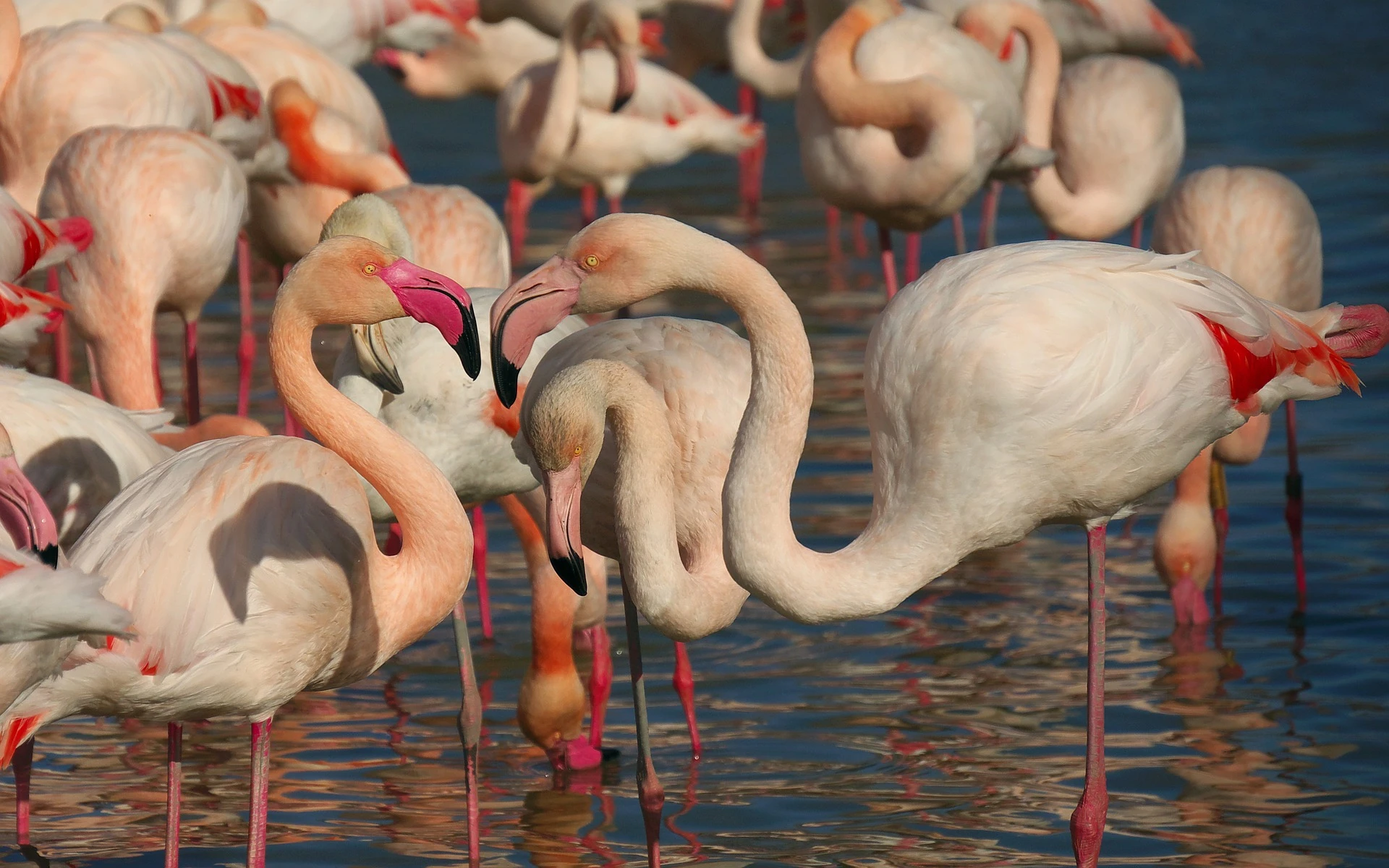 The pink flamingo is very common in the Camargue, where around 30,000 individuals are recorded each year. Photo selected by monsieurdefrance.com: gayulo from Pixabay
The pink flamingo is very common in the Camargue, where around 30,000 individuals are recorded each year. Photo selected by monsieurdefrance.com: gayulo from Pixabay
On the left side of the estuary, on the Gard side, you can see European pond turtles. They are rare and endangered, but they thrive in their little corner of the Camargue. Similarly, the cattle egret, so named because it eats the numerous insects that harass livestock, particularly the famous Camargue bulls.
A cattle egret on the back of a horse. It feeds on the many insects found in this humid country. Photo selected by monsieurdefrance.com: by Pfüderi from Pixabay.
What is a manade in the Camargue?
Bulls and horses in semi-freedom
In short, these are animals that roam freely or semi-freely. Herds of bulls or horses are tended and led by a man on horseback called a gardian. The Camargue bull is highly prized for bullfighting events, particularly bull races. Its meat is highly sought after and has been awarded an AOP (Appellation d'Origine Protégée) designation. It is eaten in a "gardiane" stew with rice and olives, cooked in red wine from the Camargue or Provence (it must be well-marbled).
Herd of horses. Photo selected by Monsieurdefrance.com Image by Christian Klein from Pixabay
The role of the gardian and bullfighting traditions
Manades have existed for centuries. The gardian leads the herds from one point to another so that the animals can change pastures. You can also follow manades in the Camargue. This website presents a few of them.
The black bulls of Camargue. Photo selected by monsieurdefrance.com: by Christian Klein from Pixabay
Cities and monuments to visit in Camargue
A beautiful discovery of traditional housing in the Camargue. Photo selected by monsieurdefrance.com by Hans from Pixabay.
Cities and monuments to visit in Camargue
A very pretty seaside town, it caught the eye of Vincent Van Gogh, who painted it in 1888.The town is often considered the capital of the Camargue, because it is at its heart, unlike Arles, the real capital, which is also further from the Mediterranean. Les Saintes-Maries de la Mer is also more typical.
A city between the Mediterranean Sea, marshes, and traditions
The small town is barely above sea level, with a maximum altitude of 6 meters. It covers a huge area of over 37,000 hectares, making it the third largest municipality in France, but it has many natural areas, including over 30% of the traditional Camargue marshes. It has just over 2,000 inhabitants.
The astonishing fortified church of Saintes Maries de la Mer. Photo selected by monsieurdefrance.com by Hans from Pixabay
The fortified church and the shepherds' huts
There are many small streets to explore and you can still sense that the town was once surrounded by ramparts, even though they have now disappeared. The fortified church dates back to the 12th century. It was fortified to protect its relics from attack, particularly from pirates. Near the Launes pond, you can see traditional huts, known as cabanes des Launes, or herdsmen's huts.
The pilgrimages of Saintes-Maries-de-la-Mer
Saint Sara, venerated in the crypt of the Church of Saintes Maries de la Mer. Photo selected by monsieurdefrance.com Visible7 via depositphotos.
Les Saintes Maries and the founding legend
First called "Notre Dame de la Mer" (Our Lady of the Sea), then "Sainte Marie que de la Barque" (Saint Mary of the Boat), the place took the name Saintes Maries de la Mer in 1838. The name Saintes Maries, in the plural, comes from the discovery of precious relics in the 10th century: those of Mary, mother of Jesus, Salome, half-sister of Mary and aunt of Jesus, Mary Jacobê (or Mary Salome), mother of Saint James, and above all Mary Magdalene, disciple of Jesus, who perfumed his feet and wiped them with her hair on the evening of the Last Supper. These Marys sometimes changed identity over time because one Mary was confused with another. For example, Mary, wife of Cleophas, was considered separate from Mary Jacobê before it was realized that they were the same person.
Saint Sara and the Gypsy Pilgrimage
According to legend, after Christ's death, the "three Marys" arrived on a boat, accompanied by a fifth saint, Sara the Black, their servant. She is particularly revered by gypsies, who come to celebrate her during very important pilgrimages. During her procession, on the eve of the pilgrimage of the Three Marys, Saint Sara is the subject of her own procession among the gypsies and is half-immersed in the sea. The Holy Marys are celebrated on May 24 and 25 and at the end of October. Saint Sara is celebrated by the gypsies on May 24. It is a very moving event.
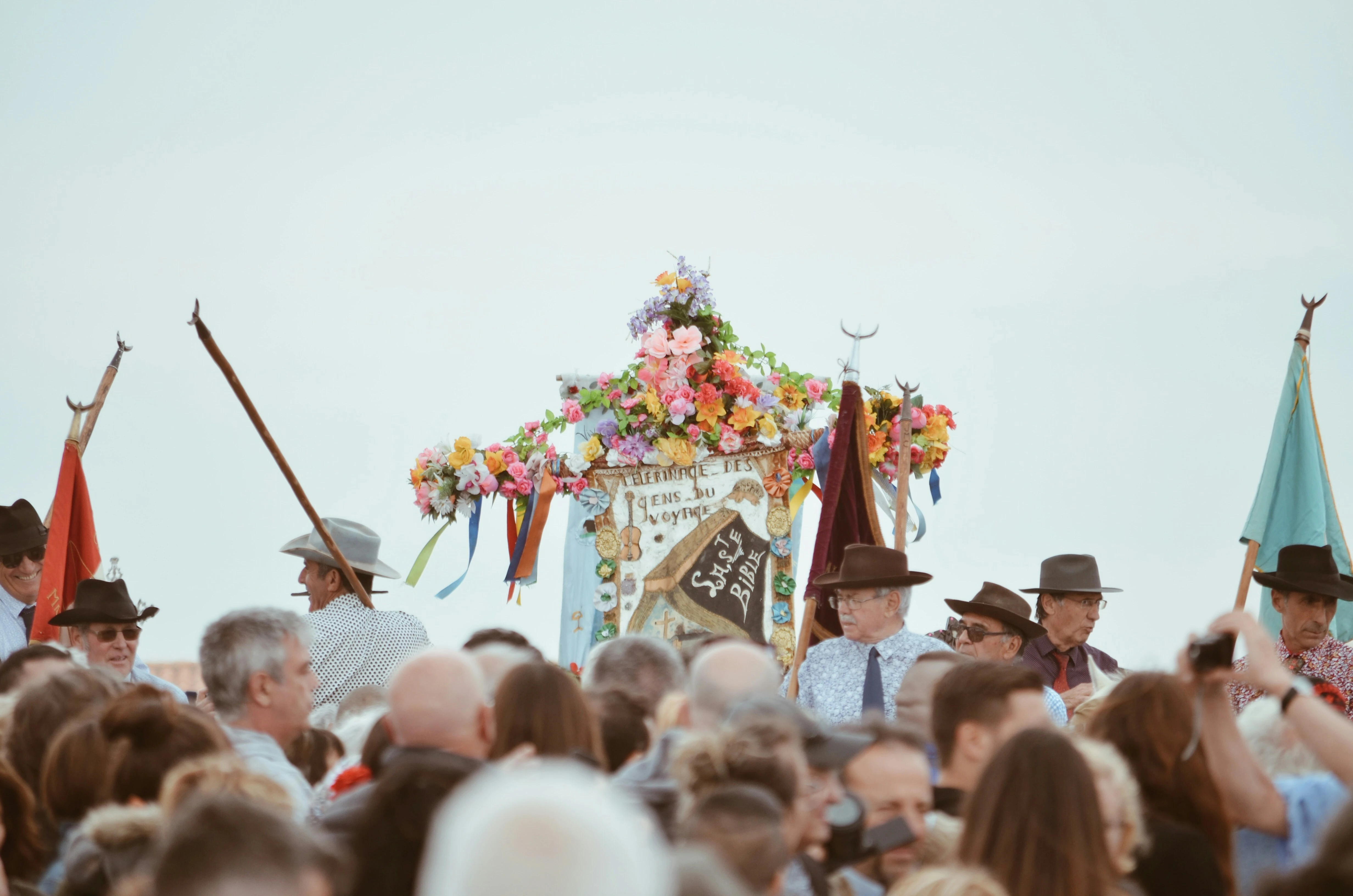 The pilgrimage. Photo selected by monsieurdefrance.com Photo by Caroline Hernandez on Unsplash
The pilgrimage. Photo selected by monsieurdefrance.com Photo by Caroline Hernandez on Unsplash
Arles, historic capital of the Camargue
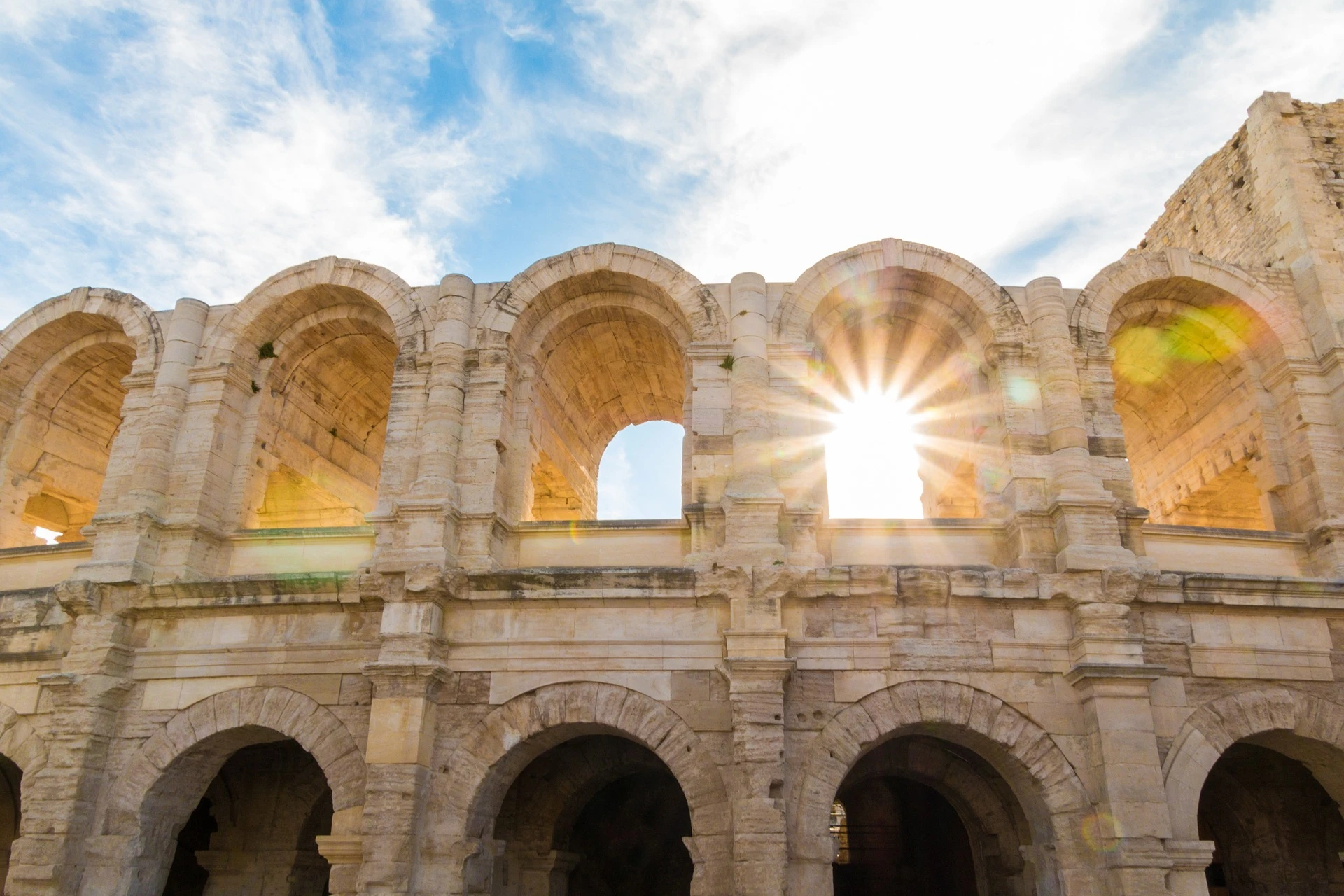 Nearly 2,000 years after their construction, the Arles amphitheater remains the pride of the city. Photo selected by monsieurdefrance.com: by Pfüderi from Pixabay
Nearly 2,000 years after their construction, the Arles amphitheater remains the pride of the city. Photo selected by monsieurdefrance.com: by Pfüderi from Pixabay
Gallo-Roman Arles and UNESCO World Heritage Site
Arles is the capital of the Camargue. Crossed by the Rhône River, which literally cuts it in two and sometimes subjects it to its whims before beginning its delta, which constitutes the Camargue, it is the largest municipality in France and includes a large part of the Camargue. It also has five nature reserves, which is exceptional for a French city (53,000 inhabitants).
Nature reserves, Alpilles and Rhône
Arles' natural environment includes: the Camargue National Nature Reserve, the Coussouls de Crau National Nature Reserve, the Vigueirat Marshes National Nature Reserve, the Ilon Regional Nature Reserve, and the Tour du Valat Regional Nature Reserve. It is also bordered by the Alpilles mountains, around the monastery of Montmajour des Olpies, the highest point at 496 meters.
One of the small streets bordering the Arles Arena, which make a stroll through this city a truly delightful experience. Photo selected by Monsieurdefrance.com: by Pfüderi from Pixabay.
Its history is rich and very ancient, as the Greeks were already talking about Arelate in the 4th century BC, shortly after they founded Marseille. Having chosen Caesar, the city became a major Gallo-Roman city, with all the amenities, notably the Arles Arena, which has survived to this day and is the city's pride and joy. Arles was also a kingdom, which is why people sometimes say "going to Arles" as if going to a country. Its rich past has left behind beautiful streets and alleys, mansions, and great monuments, including 44 listed historical monuments, among which the Roman monuments, mainly the amphitheater, are classified as World Heritage Sites by UNESCO. You're sure to find a good restaurant in the small streets and squares, not far from the obelisk in Place de la République. Arles is also known for its Easter feria, its Rice Feria (in September), and its photography festivals. It's a great place to take superb photos, including modern ones with the amazing LUMA Arles, an art complex whose striking architecture is well worth a visit.
One of the few busts of Caesar is located in Arles. It is believed to be one of the only busts of this great historical figure. Photo selected by monsieurdefrance.com; by Guy Dugas from Pixabay.
The Arles Antique departmental museum is a rather unique place that tells the prestigious history of Arelate during its Gallo-Roman heyday. It features moving busts, including one of a child, and above all one of the only (supposed) busts of Julius Caesar. Take the time to visit it and marvel at the artistic skill of people from 2,000 years ago.
Aigues-Mortes, a fortified town in the heart of the marshes
The departure of Saint Louis on crusade from the port of Aigues-Mortes. Illustration chosen by monsieurdefrance.com : By Guillaume de Saint-Pathus, Life and Miracles of Saint Louis — http://www.usu.edu/markdamen/1320Hist&Civ/chapters/15CRUSAD.htm, Public domain, https://commons.wikimedia.org/w/index.php?curid=4122269
Saint Louis, ramparts, and port of crusade
The fortified town is magnificent. We are here in the Gard department. Surrounded by ramparts, like a small Carcassonne by the sea, it was built at the behest of King Saint Louis (1214-1270), who wanted a fortified port from which to set sail on his crusades. Take the time to walk around the ramparts, pass by the Tour de Constance and visit the town's churches, particularly the Chapel of the White Penitents and the Chapel of the Gray Penitents. The arenas are called the Plan des Théâtres and are the scene of major Camargue races.
Salt marshes, protected nature, and Camargue traditions
Around the city, nature lovers will find three Natura 2000 areas: Petite Camargue, Étang du Mauguio, and Petite Camargue Laguno-Marine. The salt marshes of Aigues-Mortes produce most of the Camargue salt at the Marais de Peccais. For children, watch out for Lou Drapé, the legendary giant horse that used to roam the streets of the city, carrying 100 children on its back, never to return...
The ramparts of Aigues-Mortes. Photo selected by monsieurdefrance.Com: by claude alleva from Pixabay
Le Grau-du-Roi, seaside resort in the Camargue region
Also in the Gard department, around the Old Lighthouse, Le Grau-du-Roi is the seaside resort of the Camargue. The town literally exploded in the 1960s when mass tourism began to develop there, but this did not cause it to lose its Camargue soul, which can be found in the historic town and in the arenas where Camargue races are still as popular as ever. Sometimes you can watch the Bandido and Abrivados, the return of the herds of bulls to the town, which is spectacular.
Port-Camargue, beaches, and bullfighting traditions
In terms of architecture, Port-Camargue and its marina, built from scratch in the 1960s, offer a glimpse into the seaside architecture of those years, which saw increasing numbers of French people going on vacation. The Espiguette lighthouse, dating from 1869, is also worth seeing. And you can relax on the beach...
The old lighthouse at Le Grau-du-Roi. Photo selected by monsieurdefrance.com: by Julia Casado from Pixabay
What to eat in Camargue? Specialties and gastronomy
Camargue rice IGP, bull, and traditional dishes
In general, the Camargue is a land of gourmet delights. You can taste the salt from the salt marshes, the famous Camargue rice, red rice for example (whole grain and excellent), which has a PGI (Protected Geographical Indication). Grown organically, it comes in red, white, and black. 120,000 tons are produced each year. The Camargue bull is also cooked; it must be said that the meat is very red and not fatty. Having grazed in the open air, it is delicious. It is mainly cooked in a stew, which makes it even better when reheated. Beef is usually cooked in a stew called brouffade. Mutton is cooked in soupe courte arlésienne, a very thick soup served with mutton and rice.
Cheeses, fish, and recipes from Arles
Arles, in fact, offers the delicious Arlesian fish soup, based on the same principle as Marseille's bouillabaisse, with conger eel, red mullet, scorpion fish, and monkfish. As for cheese, there is Tomme de Provence and Tomme d'Arles, whose recipes are said to date back to the ancient Roman presence, which says a lot about the expertise involved.
The famous Camargue rice. Photo selected by monsieurdefrance.com: foto-pixel.web.de via depositphotos.
Local delicacies: fougasse d'Aigues-Mortes and beignets
You can also indulge your sweet tooth in Camargue and try fougasse d'Aigues-Mortes, one of the oldest yeast-based pastries, which is one of the 13 Christmas desserts in this corner of Provence. It is a kind of brioche with sugar flavored with orange blossom. On the beach or in the street, instead of churros, you can try fregis, which are long doughnuts cooked in oil. Fatty but delicious!
How to get to the Camargue? Access and transportation
Coming to the Camargue by car
Arles is located 7 hours and 15 minutes from Paris (via the A7 and A6 highways), 1 hour from Marseille (96 km), and 3 hours from Lyon (283 km).
Les Saintes Marie de la Mer is 38 km from Arles (37 minutes), and Le Grau du Roi is 53 km from Arles (50 minutes). There is a bus service. The same applies to Aigues Mortes.
Access by train: Arles and Aigues-Mortes
It takes between 3 hours 30 minutes and 4 hours 15 minutes to travel from Arles to Paris by train. Arles train station is located on Avenue Paulin Talabot. There is also a train station in Aigues-Mortes, located at 115 Route de Nîmes.
Guardians in action. Image selected by monsieurdefrance.com: by 2554813 from Pixabay
Airports near the Camargue
Marseille Provence Airport (1 hour from Arles)
Avignon Airport - 84140 Montfavet - www.avignon.aeroport.fr (50 minutes from Arles)
Nîmes Grande Provence Méditérranée Airport. - 30800 Saint-Gilles - www.nimes.aeroport.fr (30 minutes from Arles)
Montpellier Méditerranée Airport - 34130 Mauguio - www.montpellier.aeroport.fr (50 minutes)
Official websites and resources to help you plan your trip to the Camargue
The best: Camargue tourism.
The official Arles tourism website. Very well done.
The Bon Port Camping site is pretty good.
FAQ Camargue
Where is the Camargue located in France?
The Camargue is located in the south of France, in the Rhône delta, between the Bouches-du-Rhône and Gard departments. It stretches between Arles, Les Saintes-Maries-de-la-Mer, Aigues-Mortes, and Le Grau-du-Roi, between the Mediterranean Sea, ponds, and marshes.
What are the must-see attractions in the Camargue?
In Camargue, you must see the pink flamingos, the salt marshes, the Vaccarès lagoon, the herds of bulls and horses, Saintes-Maries-de-la-Mer, Arles, and Aigues-Mortes. These sites embody the wild nature, traditions, and iconic heritage of the region.
When is the best time to visit the Camargue?
The best time to visit the Camargue is in spring and fall. Temperatures are pleasant, nature is active, and there are fewer tourists. Summer is hot and crowded, while winter offers the chance to see more flamingos.
How many days does it take to visit the Camargue?
You need at least three days to visit the Camargue. This gives you time to discover the natural landscapes, observe the wildlife, and visit Saintes-Maries-de-la-Mer and Arles. A week is ideal for exploring the reserves, beaches, and villages at a leisurely pace.
Where can you see flamingos in the Camargue?
Flamingos are mainly found around the Vaccarès lagoon, in the salt marshes, and at the Pont de Gau bird sanctuary. They are present all year round, but their color is more intense in winter, when their plumage thickens.
Can you see bulls and horses roaming free in the Camargue?
Yes, the black bulls and white horses of Camargue live in semi-freedom in the manades. They can be seen in the meadows, marshes, and during supervised movements by the gardians, particularly during abrivados and visits to the manades.
What is a manade in the Camargue?
A manade is a traditional herd of bulls or horses living in semi-freedom in the Camargue. The herds are supervised by herdsmen on horseback. Manades are at the heart of Camargue culture and local bullfighting traditions.
What is the capital of the Camargue?
Arles is considered the administrative capital of the Camargue. It covers a large part of the Camargue region and has a rich historical heritage. Les Saintes-Maries-de-la-Mer is often seen as the cultural and symbolic capital of the Camargue.
Is it easy to get around the Camargue without a car?
Getting around the Camargue without a car is possible but limited. Buses connect Arles, Les Saintes-Maries-de-la-Mer, Aigues-Mortes, and Le Grau-du-Roi. However, a car or bicycle makes it easier to access natural sites, marshes, and the wildest areas.
What to eat in the Camargue?
In Camargue, people eat Camargue IGP rice, bull stew, brouffade, Mediterranean fish, and fougasse d'Aigu

